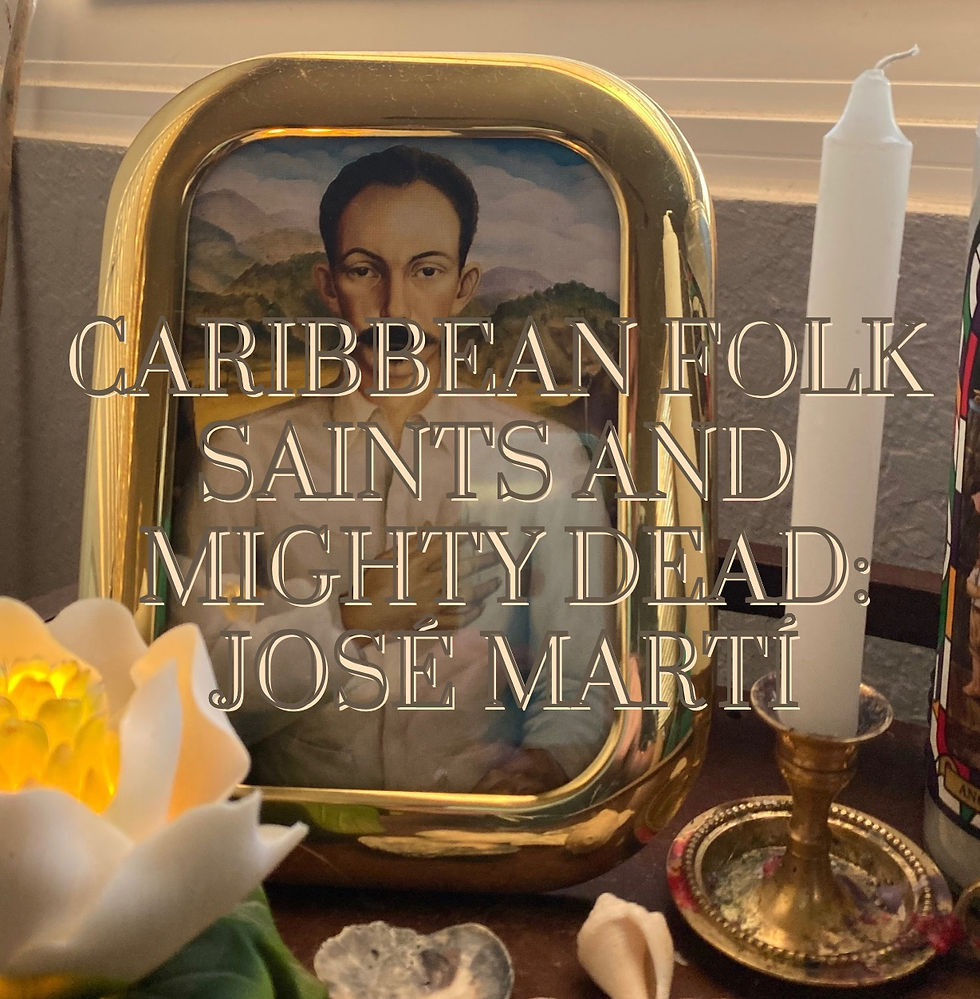Caribbean Folk Saints and Mighty Dead: José Martí
- RJ Hernandez
- Nov 29, 2024
- 3 min read

Known as The Apostle of Cuban Independence, José Martí was a poet as well as one of Cuba’s most well known Mambises (revolutionaries) and martyrs. He was born January 28th, 1853 and died in battle May 19th, 1895. His influence on Cuban identity and nationalism are still seen today.

Any child who grew up in Cuba or with roots reaching back to Cuban Independence will recognize the face of José Martí. His iconic writings have been turned into songs like “Guantanamera”, serving as patriotic anthems of the Cuban consciousness. I know as a child my grandfather told us many times about war heroes like Martí and Hatuey. Both figures are important to Cuba, but also especially important to the Indigenous peoples who have elevated them.
Born a criollo man in the Havana province, Martí was a lifelong activist and writer. His writing on liberation and abolition were vital to these movements in Cuba but also globally. He spent much of his life traveling around before returning to Cuba. He started several newspapers and publications, most famously one simply known as “Patria” where he would share useful information and news that favored the revolutionary cause. Martí was also prolific in his writings on Indigenous Peoples of the whole world, being quoted saying “Until all Indigenous People are liberated, none of us are free”. It was also Martí’s efforts in the East of Cuba that convinced the Indigenous Cubans contracted by the Spanish to instead fight for the revolution alongside their families with the promise of sovereignty and respect.
He founded the Cuban Revolutionary Party in Key West on January 5th, 1892. Thats right, here in Florida. He also worked for the independence cause in Ybor City, planning with former 10 Years War veterans. It’s important to remember at the time of his birth, Florida had not even been a state for a decade. This land was instrumental in the Cuban Revolution from Spain.
His death in the Battle of Dos Rios was the final blow to the Spaniards social hold over the island. It united both revolutionary and loyalist Cubans under a common threat, because Martí along with his lifelong Afro-Cuban Revolutionary partner Juan Gualberto Gómez represented every Cuban who had been beaten by the Spanish system. Though the war did not end for several more years with the intervention of the U.S., this moment is when many consider the war decided. He was buried in Santiago de Cuba.

VENERATION
For this post, I wanted to take my time and really allow my relationship with El Apóstol to develop and lead me where it led. I can confidently say, after more than six months under his direct tutelage and veneration that I have learned so many new skills and made new connections all which correspond to his more liberating aspects.
He is a spirit of Love at his core. Love for his Land and People but also for the world as a whole. Don’t mistake this for meaning he is a gentle spirit though. He is tough, firm and forceful. He is strong and revolution is essential to his being, whether that be politically or simply intellectually.
I have been honoring him through pilgrimages to sites sacred to him, including Cayo Hueso (Key West) and Ybor in Tampa. I also light white candles in his name, often when writing or creating content especially. I find he enjoys the things I share, so devoting it to him in his honor is one of my favorite offerings. He does also enjoy Tabaco. Be mindful though, working with him may inspire boldness in your choices and language. I know personally I have become less tolerant of colonizer BS on my page since connecting deeper with Martí.
When I am needing inspiration, or seeking guidance or a new avenue of connection as it relates to anything regarding the Land or my ancestry in Cuba, which is a majority of my practice. I also find reading his works aloud and in silence both help to call him in as well as inspire me in moments of blockage. I will include some of his writings so you can get an idea of the words that shaped the Revolution.
Bendicones.

I CULTIVATE A WHITE ROSE
I have a white rose to tend
In July as in January;
I give it to the true friend
Who offers his frank hand to me.
And for the cruel one whose blows
Break the heart by which I live,
Thistle nor thorn do I give:
For him, too, I have a white rose.
CULTIVO UNA ROSA BLANCA...
Cultivo una rosa blanca,
En julio como en enero,
Para el amigo sincero
Que me da su mano franca.
Y para el cruel que me arranca
El corazón con que vivo,
Cardo ni oruga cultivo:
Cultivo la rosa blanca.




Comments